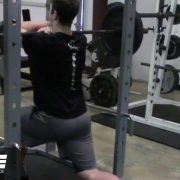Should Baseball Pitchers Use Long Distance Running for Conditioning?
We figured it out years ago, and it was a good thing we did: Conditioning for pitchers needed to change. Strength coaches declared Sprinting is the way! Down with distance running! All of a sudden, gone were the days of jogging mile after mile, pole after pole.
But, is this the only way? Is every other type of running “making us slow?” As both a veteran pro pitcher and strength coach, I say no. We strength coaches have been making impractical, dogmatic recommendations that need to improve.
Good Advice Gone Too Far?
Strength coaches meant well when we banned distance running: sprinting better suits the needs of a baseball pitcher by training them to be more explosive. A pitcher isn’t continuously moving for seven to nine innings with an elevated heart rate like that of a distance runner. Rather, he explodes; gathers; repeats. He is most like a cheetah, going full-speed or lying in wait with little in between.
But as leaders in the industry, we should worry about how others interpret our information. What started out as a smart new way to condition pitchers has become a source of dogma, confusion, and, in many cases, a new problem. I heard again recently, from a coach I greatly respect:
Pitchers should only do sprints. I’d never have them run anything longer than 60 or 100 yards; any more than that makes them slow.
The advice might be sound, but it’s not one bit practical.
This is also a case where any finger I point comes right back at me. I’ve written this same statement in previous articles, expressed the same sentiment to coaches and players over the years. I embraced the never run distance mentality in college and tried implementing it during much of my pro career. “No distance for me,” I declared! A year or two in, I stopped flying that flag in favor of the everything in moderation flag.
The Problem: A Program is Only Good If People Follow it
The problem here lies in the real-world practicality and application of a sprinting-only conditioning regimen. I’m a firm believer that any training program is only as good as its:
- Practical application – is it realistic given the resources and the environment a person lives in?
- Realistic expectations – would most players actually be motivated to do it? Or is it too hard?
- Viability in both the short and long term – will this just burn a player out, cause injury or put him further off-track later on? Can it work for years to come?
I lived on both sides of the fence, both as a full-time strength coach and as a pro pitcher who spent multiple seasons as both a reliever and starter. I killed myself with strength in conditioning in college, and now have perspective on what striking a balance feels like.
I’ve watched former Major Leaguers conduct their pre-game routines, and helped rookie players build theirs. I know what it feels like to do pre-game sprints at 3:00 pm, in 95-degree heat, before game #118 in late August. Programming workouts for tired, beaten-down ballplayers is not as straightforward as it is sometimes professed to be.
Here’s what your players are thinking when you tell them that sprinting is the only thing that’s good for them…
#1. If Sprinting Is My Only Option, And I Don’t Have the Energy Today…What Else Do I Do?
If running slowly will make a player worse, and he’s too tired, hurting, or unmotivated to sprint, then he may just pack it in and not do any conditioning. Is that what we want? In a good baseball strength training program, we need to find balance.
I personally don’t believe that doing nothing is better than doing something. Is a 10-minute jog on a day when I’m exhausted really that bad for me? Especially if I don’t have the energy in my legs to legitimately sprint?
#2. Our “Sprints” Are Actually Hard Jogs – Is That Still Worthwhile?
If you haven’t watched players sprint in pre-game – at any level – then you need to. 90% of them perform a half-hearted effort that is five hard steps followed by coasting. Most “sprints” are merely hard, short runs.
If a coach prescribes six 60yd sprints, he’ll get a 360yard hard jog…which is useless.
#3. Sprinting is Hard and It’s Very Hot Outside. Are You Sure It’s Good For My Longevity?
I think coaches sometimes forget. A 90% sprint won’t build the power and explosiveness that we intend. So if a player bears down and truly gives 100%, the time, does my likelihood of injury increase? They still have baseball to play, after all.
You want me to run only sprints in the months of June, July and August? In pre-game when it’s 95 degrees for three straight months and I have a game every night?
My knees hurt, my Achilles tendons are swollen. I wear cleats for 4 hours a day. Is sprinting really the best thing for me? What if I can only go 70% without pain? Is sprinting all the time good for my longevity? Will I start breaking down earlier?
A reasonable volume of sprints for a relief pitcher is 200-300 total yards per day. It’s a little longer than that on the sprint days for starters. 200-300 yards breaks down into four 40s and two 60s, or seven 40s. If you run those hard, it takes a lot of out of you when you’re on your feet all day, pitching at night with two days off per month as a pro.
And it’s not better as a college player. They have practice on non-game days. They walk to class.
Or as a high schooler. They play other sports and have practice for all of them. They don’t get enough sleep or eat enough.
#4. We Don’t Build Good Conditioning With the Amount of Sprints We’re Often Capable of Doing.
Personally, I pitched better when I was in good cardiovascular shape. I felt stronger on really hot days and my body reacted in a more positive manner to in-game stresses like pressure situations. Good conditioning allowed me to feel stronger and more in control when I was under fire.
And, I knew that I couldn’t get enough volume in sprints to both stay sane, stay healthy, AND get into good shape – it’d take too much sprinting to build the cardiovascular endurance I wanted, and my knees sometimes start barking at me late in the year.
#5. We Don’t Lose Our Velocity or Ability Because of a Few Lousy Jogs.
During my playing career, I jogged or ran longer distances 1-2 times per week in the offseason and in-season. Nothing changed, except it allowed me to stay in better shape, burn more calorie and keep my bad weight down, and gave me something to do when I was too tired for more of those horrible sprints.
What’s wrong with moderation? Certainly a jog or longer set of intervals once or twice per week won’t ruin me.
Does anyone have an example of when a player showed some measurable decrease in velocity because he ran distances longer than 60yards a few times per week? If it’s as ruinous as we all claim, there should be casualties.
#6. Longer Distances Have Value In Other Ways
400 meter sprints are maybe the hardest thing I did as a player. In the last 150 meters, your body starts flailing because of how tired your legs, core, upper back, and lungs get. You try – often in vain – to not trip over your feet. You feel your core legitimately give out; a jellyfish-like feeling ensues as your limbs feel out of control.
Is this not the same phenomenon we try to prevent in the 7th inning of a start? Pitchers get tired – in their legs, their arms and their core – and they try to hold their mechanics together. I think 400 meter runs do a darn good job providing functional conditioning: giving a pitcher the mental and physical conditioning to keep themselves together and make good pitches late in the game.
#7. Isn’t Everyone Different? What About Individuality?
Most good strength coaches are champions of individuality, constantly reiterating that we should place all our clients into the same category, program, etc. But with conditioning recommendations, it’s pretty much one-size-fits-all. Why is there a disconnect?
I totally understand that though unique, we are all united with standards – yes, all baseball players need explosive training, no matter who we are. But, we are also all wired a little differently; can you really say that jogging hurts me, even when I say that my body feels better, I think I pitch better, and it keeps me in good cardiovascular shape?
Talk to pitchers. Some say that they thrive on a little (or a lot) of distance running. Sure, maybe they don’t know that they’d be better if they changed their ways. Or, maybe they’ve found what works for them.
Where We Go From Here
I think most strength coaches would agree that 75% effort sprints aren’t the way to more explosive pitchers. But, in years of observing my peers in pro baseball, 75% is the average effort level with which pitchers perform their sprints.
I think it’s safe to say that if you’re prescribing sprints, your players will give you 75% effort sprints on most days. Do your recommendations change, knowing that? Why not run 75% effort for longer distances, to let them burn more calories and challenge their heart and lungs?
Or, we can dial it back, be less dogmatic, and allow more diverse conditioning choices so that when players are told to sprint, they actually feel able to give it a true 100%. We need to admit to ourselves that some longer distance runs aren’t leading to any measurable decline in the velocity or ability of pitchers who do them.
A vast number of players jog as part of their routines and it can’t be killing all of them. Could they be made a little better by sprinting more? Maybe. But, the common sprinting prescription is akin to a doctor telling a diabetic patient to eat nothing but vegetables. Sure – great advice for his long term health! But, it’ll never happen. Such unrealistic advice just shows that the doctor isn’t in tune with how to help his patients improve their habits. A strategy that shows a balance of best-case scenario and realistic expectations is best.
Creating a Balance Conditioning Plan
We should be looking to advocate for balanced conditioning plans, ones that better address the following:
- Reasonable demands of mental and physical energy
- Accumulated fatigue over a long season
- Environmental demands such as the oppressive late-summer heat
- Individual differences in what makes a player feel prepared
- Starter versus reliever
- Body composition, prior injury history
- The desire to keep pre-game routines motivating and challenging
- Many athletes don’t have access to joint-saving cardio machines like bikes or ellipticals that can still allow for a decent workout with reduced stress
Preparation is Key
Finding balance in training programs is as difficult in baseball as in any other sport – there are so many unique demands and the season is so long. But, if we marry practical advice with sound methodology and exercise choices, then we can better prepare ballplayers to both get better and stay healthy for the long term.
Dan Blewett
Latest posts by Dan Blewett (see all)
- What Causes A Mental Meltdown in Baseball? - September 3, 2019
- Two Common Curveball Mistakes Pitchers Should Avoid - July 30, 2019
- Is Heavy Lifting Good For Pitchers? - July 2, 2019











What’s up Dan! I’m a fellow baseball player, pitcher, and was curious about this subject. I love going on runs like 1mile or 3 or even 5miles. I have always heard this is bad for pitchers, so I stopped doing them even though I enjoy them. This advice is similar to that you highlighted in the article. It sounds like based on what you said they’re fine to do, especially if I want to. Would love to gather your thoughts…thanks, gavin
My grandson’s pitching coach suggested that he go for a short run after pitching in a game. He said that when he had played pro ball that he was told that it helped release anxiety, reduce normal inflammation, and improve circulation. This would improve healing, release stress, and reduce recovery time.
Great insights! I never considered the impact of long-distance running on a pitcher’s performance. It seems like incorporating different types of conditioning could really help with endurance and recovery. I’d love to see more discussion on how this approach compares to other training methods specifically for baseball players.
This was a fascinating read! I’ve always wondered about the balance between endurance training and the specific needs of a pitcher. The insights on anaerobic conditioning and its relevance to pitching performance were particularly valuable. I can see how incorporating some long-distance running could help, but I also appreciate the emphasis on sport-specific training. Thanks for shedding light on this topic!
This post offers some great insights! I’ve always wondered how long-distance running impacts pitchers’ performance. It makes sense that their conditioning needs to be specific to the demands of pitching. I appreciate the balance you discussed between endurance and explosive strength. Would love to see more on alternative conditioning methods as well!
Great insights on the debate around conditioning for pitchers! I’ve always wondered about the balance between endurance and strength training. It makes sense that a tailored approach can benefit pitchers more than a one-size-fits-all strategy. Looking forward to trying out some of the suggested drills!
Great insights! I’ve always wondered about the balance between endurance and explosiveness in a pitcher’s training regimen. It makes sense that while long-distance running has its benefits, a more tailored approach focusing on short bursts and agility would be more beneficial for optimal performance on the mound. Thanks for shedding light on this topic!
Great insights in this post! I never really considered how long-distance running could impact a pitcher’s performance. It makes sense that conditioning needs to be tailored to the specific demands of the role. I’m excited to see how this approach can enhance endurance and recovery for pitchers. Thanks for sharing!
I found this post really insightful! It’s interesting to consider how long-distance running can affect a pitcher’s performance. I’ve always thought that sprinting drills were the way to go, but you made a strong case for the benefits of aerobic conditioning. I’d love to see more about how to balance both types of training in a pitching regimen!
Great insights on the conditioning debate! I always wondered how pitchers balance endurance training without compromising their strength and explosiveness. I think it’s crucial to tailor conditioning programs specifically for their needs. Would love to see more examples of what effective workouts look like!
Great insights! I’ve always wondered about the balance between endurance and strength training for pitchers. It makes sense that mixing in some long-distance running could enhance overall stamina, but I’m curious about how it impacts arm strength and recovery. Would love to see more examples of how different pitchers incorporate these methods!
This was a fascinating read! I always wondered how different conditioning methods could impact a pitcher’s performance. The insights on the balance between endurance and strength training really resonated with me. It makes me think about how important it is to tailor conditioning specifically for the demands of pitching. Thanks for sharing these valuable perspectives!
Great post! I found the insights on how long-distance running impacts pitchers’ performance really interesting. It’s fascinating to consider the balance between endurance and explosive strength in their training. I’d love to hear more about alternative conditioning methods that might work better for pitchers. Thanks for sharing!
Great insights! I never considered how long-distance running could impact a pitcher’s performance. It’s interesting to think about balancing endurance with the explosive power needed for pitching. I’m curious about how different training regimens could affect recovery times too. Thanks for sharing!
Great insights! I always thought long-distance running was counterproductive for pitchers, but your points on its benefits for endurance and recovery are convincing. It’s interesting to consider how different conditioning methods can impact performance. Thanks for addressing such an important topic!